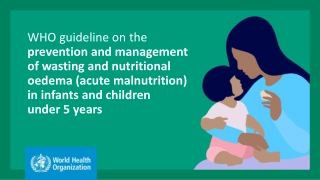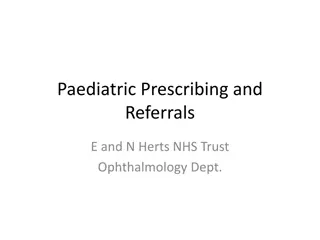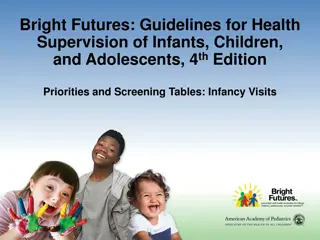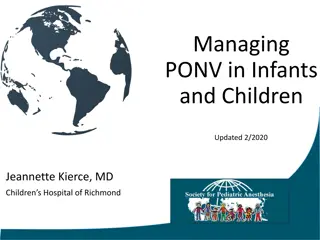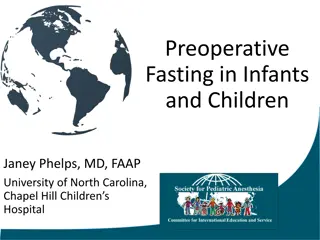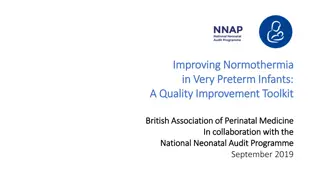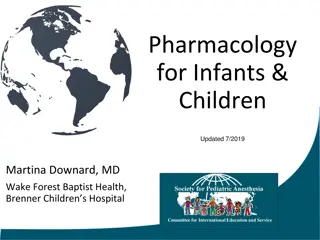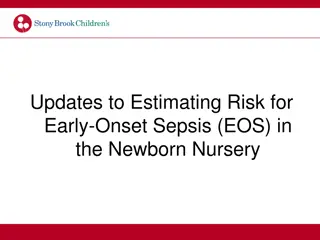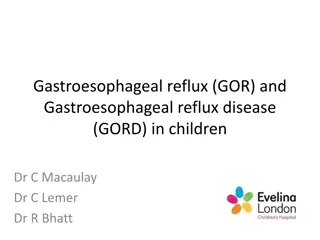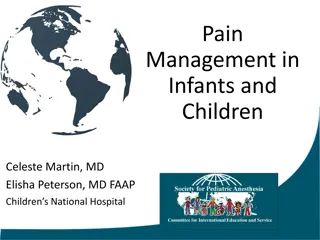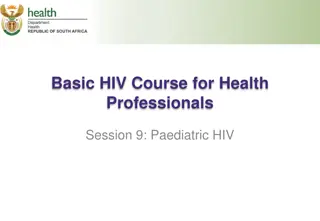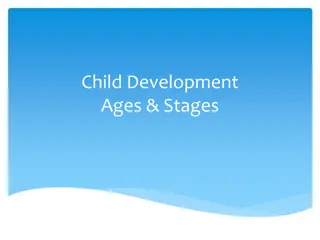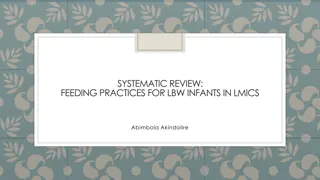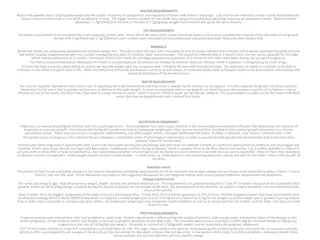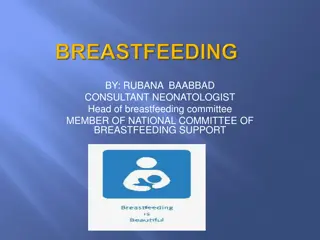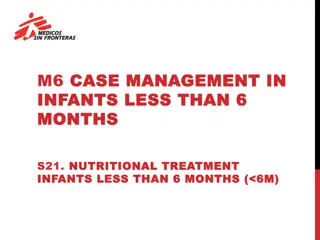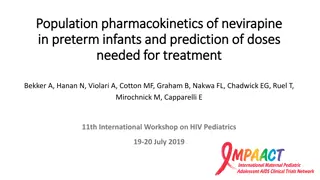WHO Guideline: Prevention & Management of Malnutrition in Infants & Children
Key insights from WHO's guideline on managing wasting and malnutrition in children under 5. Covers assessment, care for infants and mothers, and treatment strategies for different malnutrition levels
3 views • 37 slides
Managing Cows Milk Protein Allergy (CMPA) in Infants: Weaning and Reintroduction Guidelines
Cows Milk Protein Allergy (CMPA) in infants can present various symptoms and challenges. This guide covers the diagnosis, symptoms, weaning strategies, reintroduction of dairy, alternative products, and meeting nutritional needs. Learn to differentiate between CMPA and lactose intolerance for proper
1 views • 31 slides
Children's and Mothers' Health Trends in Northern Ireland 2021/22
Children's health in Northern Ireland showed various trends in 2021/22, including a high rate of infants born by Caesarean section, percentages of pre-term births, multiple births, infants breastfed, low and high birth weights, and overweight and obese children. Mothers' summary in 2020/21 indicated
1 views • 23 slides
Understanding the Measurement Trends and Data Gaps in Low Birthweight Worldwide
Explore the challenges and progress in measuring, understanding, and addressing low birthweight (LBW) in newborns globally. The data reveals significant gaps in LBW data collection and highlights the need for focused efforts to reduce LBW rates and improve newborn health outcomes.
3 views • 19 slides
Newborn Screening Market Share to be Worth $2.69 Billion by 2031
Newborn screening is a screening program for infants under which pre-symptomatic congenital conditions are detected so that treatment can be commenced as soon as possible to prevent or reduce the long-term consequences of the disease. These programs are usually run by the national or state governing
0 views • 3 slides
Beginning Junior Infants
Welcome to the exciting journey of Junior Infants! Get essential tips on preparing your child for school, including advice on school uniform, lunchtime, and the curriculum. Discover how to support your child's early education effectively.
0 views • 15 slides
Spectacle Prescribing Guidelines for Infants and Children
This paper explores guidelines for prescribing spectacles to infants and children, focusing on considerations such as refractive errors, normal visual development, and the impact of spectacles on visual function and emmetropisation. It discusses refractive errors and astigmatism prevalence from birt
0 views • 34 slides
Bright Futures: Guidelines for Health Supervision of Infants, Children, and Adolescents
This content provides a comprehensive guide for health supervision of infants, children, and adolescents based on Bright Futures guidelines. It includes priorities and screening tables for various visits from newborn to 9 months, offering valuable insights into the developmental stages and health mo
0 views • 16 slides
Managing Postoperative Nausea and Vomiting in Infants and Children
Postoperative nausea and vomiting (PONV) is a significant concern in pediatric patients due to their increased risk compared to adults. This presentation by Dr. Jeannette Kierce covers the pathophysiology, risk factors, prophylaxis, and rescue treatments for PONV in infants and children, emphasizing
0 views • 34 slides
Understanding Hypotonia in Infants: Causes, Evaluation, and Management
Hypotonia, which is reduced muscle tone, can present challenges in infants affecting their motor skills and posture. This article explores the definitions, physiology, differences in central and peripheral causes, evaluation methods, and management options for hypotonia. It discusses relevant termin
0 views • 40 slides
Preoperative Fasting in Infants and Children: Guidelines and History
Explore the evolution and rationale behind preoperative fasting guidelines in infants and children, including historical cases of aspiration during anesthesia. Learn about Mendelson Syndrome, recommendations for aspiration prevention, and the development of NPO orders over the years. Discover the im
0 views • 26 slides
Understanding Cortical Visual Impairment in Infants
Cortical Visual Impairment (CVI) is a condition resulting from retrogeniculate brain damage that affects visual processing in infants. Commonly observed in premature infants, CVI can manifest as atypical behaviors like staring at lights, optic atrophy, and nystagmus. The causes range from structural
2 views • 23 slides
Quality Improvement Toolkit for Improving Normothermia in Very Preterm Infants
This resource provides a comprehensive toolkit developed by the British Association of Perinatal Medicine in collaboration with the National Neonatal Audit Programme to assist clinicians in neonatal units in delivering normothermia to very preterm infants. It includes evidence-based interventions, d
1 views • 17 slides
Pediatric Pharmacology Update: Perioperative Medications in Infants and Children
Gain insights on frequently used medications in the perioperative period for infants and children, including anesthesia medications. Explore pharmacokinetics, drug distribution in neonates, and the effects of common anesthesia agents on pediatric patients. Understand how immature kidney or liver fun
0 views • 43 slides
Understanding Early-Onset Sepsis (EOS) Risk Factors and Management in Newborns
Neonatal Early-Onset Sepsis (EOS) is a rare but life-threatening condition primarily caused by Group B Streptococcus (GBS) or Escherichia coli. Recognizing risk factors such as maternal age, intrapartum fever, GBS colonization, and certain neonatal characteristics is crucial for timely evaluation an
0 views • 26 slides
Understanding Gastroesophageal Reflux in Children and Infants
Gastroesophageal reflux (GOR) and gastroesophageal reflux disease (GORD) are common issues in infants, often causing distress to parents. While most cases resolve by one year of age, some children are at higher risk due to various factors. It is important to watch for red flags and seek pediatric ad
0 views • 10 slides
Welcome to Beginning Junior Infants - A Guide for Parents and Guardians
Welcome to the exciting journey of your child's formal education as they start Junior Infants. This guide provides essential information on school preparation, uniform, school routines, curricular activities, and the Aistear curriculum framework. Learn practical tips to support your child's learning
0 views • 13 slides
Understanding Pediatric Pain Management
Explore the complexities of managing pain in infants and children, including defining pain, classifying different types of pain, understanding pain assessment tools, identifying medication classes for treatment, and recognizing special considerations. Discover insights on acute and chronic pain, neu
1 views • 40 slides
Association of Renal and Cerebral Near Infrared Spectroscopy with Low Cardiac Output in Single Ventricle Patients
Near-infrared spectroscopy (NIRS) has been studied in infants after Stage I palliation surgery to assess its association with low cardiac output and adverse outcomes. This retrospective study investigated postoperative cerebral and renal NIRS values in infants with single ventricle physiology. Resul
0 views • 13 slides
Paediatric HIV Testing and Treatment Guidelines
Understanding the importance of early diagnosis in HIV-infected infants and children is crucial for timely intervention and improved health outcomes. This session covers testing algorithms, initiation of antiretroviral therapy, viral load monitoring, and legal issues related to HIV testing in childr
2 views • 31 slides
Detection of Low-Grade Hemorrhages in Preterm Infants: Ultrasounds vs. MRIs
This study compares the effectiveness of head ultrasounds and brain MRIs in detecting low-grade hemorrhages in preterm infants. It discusses the incidence of intraventricular hemorrhage (IVH) in very low birth weight infants, classification of IVH, risk factors for IVH, outcomes related to IVH grade
9 views • 33 slides
The Fascinating Journey of Language Acquisition in Children
At birth, infants cannot comprehend or produce speech, but by the age of 4, they have acquired vocabulary and grammatical rules to form various sentence structures. From vocalization to babbling and then to speech, infants progress through distinct stages in language development. Understanding how i
0 views • 32 slides
Sewing Club Making Weighted Bibs for Infants at MUSC Children's Hospital
Our Buist Sewing Club, inspired by the unity during the Bosnian War, creates weighted bibs for infants at MUSC Children's Hospital. These bibs provide comfort and aid in circulation post-surgery, benefitting over 137,000 children annually. Through our diverse group, we aim to make a positive impact
0 views • 15 slides
Child Development Ages & Stages: From Infancy to Toddlerhood
This comprehensive guide outlines the various stages of child development from infancy to toddlerhood. It covers the physical, cognitive, and social milestones that infants and toddlers reach, including milestones such as grasping reflexes, babbling, crawling, and self-feeding. The content highlight
0 views • 25 slides
Understanding Physical Growth and Development in Infants
Human development during infancy involves significant physical, cognitive, emotional, and social growth. This module explores the physical growth patterns, brain development, motor skills, perceptual abilities, and nutritional needs of infants. It also discusses the impact of breastfeeding, sleep co
0 views • 35 slides
Understanding the Impact of Secondhand Smoke on Infants with Cystic Fibrosis
Studying infants with cystic fibrosis exposed to secondhand smoke revealed that those in smoke-free homes experienced better growth and lower risk of bacterial infections compared to those with smoking parents. Creating a quit plan for smokers is essential to improve health outcomes and prevent rela
2 views • 25 slides
Feeding Practices for LBW Infants in LMICs
Improved survival rates of small babies highlight the importance of nutrition for LBW infants. Research into feeding practices in LMICs is crucial for promoting growth and development. Studies compare formula milk to human milk, exploring effects on growth, development, morbidity, and mortality. Evi
0 views • 21 slides
Changes to Neonatal BCG Programme: Updated Timing and SCID Evaluation
The Neonatal BCG Programme has undergone changes, including shifting the timing of the BCG vaccine administration from birth to 28 days and introducing Severe Combined Immunodeficiency (SCID) evaluation. This session aims to educate on the modifications for safe practice. The BCG immunization progra
1 views • 12 slides
Importance of Feeding Infants with Breast Milk and Iron-Fortified Formula
Breast milk and iron-fortified infant formula are recommended for infants to meet their nutritional needs and support optimal development. Breast milk offers numerous health benefits, protecting infants from illnesses and reducing the risk of obesity. Iron-fortified formula is a suitable alternative
0 views • 23 slides
Guidance for Complementary Feeding in Infants
After 6 months of age, breastfed infants may struggle to meet their nutrient needs from milk alone, necessitating the introduction of complementary foods. Implementing guiding principles can help ensure optimal nutrition and growth, including exclusive breastfeeding for the first 6 months, practicin
0 views • 18 slides
Safeguarding Infants from Emotional Maltreatment: What Works?
Safeguarding infants from emotional maltreatment is crucial during the first two years of life. Emotional abuse, though not always accompanied by physical or sexual abuse, can have severe impacts on a child's development. The paper explores the structure, prevalence, and impact of emotional abuse on
3 views • 59 slides
Newborn Care Curriculum for Late Preterm Infants in Level II NICU
This curriculum module focuses on the care of late preterm infants in Level II NICU settings, covering topics such as respiratory management, feeding difficulties, hypoglycemia, hypothermia, sepsis, hyperbilirubinemia, and discharge planning. It includes learning objectives, nursery care levels, phy
1 views • 42 slides
Nutritional Requirements for Infants, Breastfeeding, and Pregnancy
Breast milk powder provides adequate protein for infants, while cow and human milk have varying qualities. Essential fatty acids are crucial for skin integrity and growth, and infants may need iron supplementation if formula-fed. Pregnancy nutrition is vital for fetal development, with deficiencies
0 views • 5 slides
Paediatric Anaesthesia Case Discussion: Challenges of Anaesthetizing an Infant with Pierre Robin Syndrome
Pierre Robin Syndrome (PRS) presents challenges in paediatric anaesthesia, especially in infants undergoing procedures like cleft lip repair. PRS is characterized by micrognathia, glossoptosis, and respiratory distress. Other syndromes associated with cleft lip include Treacher Collins syndrome, Gol
0 views • 56 slides
Overview of Pulmonary Hemorrhage in Infants
Pulmonary hemorrhage in infants is a severe condition characterized by bloody discharge from the upper respiratory tract or endotracheal tube, often associated with prematurity, lung complications, infections, or trauma. The etiology, pathophysiology, clinical manifestations, and diagnosis of pulmon
0 views • 14 slides
The Importance of Breastfeeding for Infants and Mothers
Breastfeeding is crucial for infants as it provides over 200 components essential for growth and development. It offers numerous health benefits, helps in postpartum recovery, reduces the risk of various diseases, and promotes bonding between mother and child. For mothers, breastfeeding aids in weig
0 views • 18 slides
Comprehensive Care for HIV-Exposed Infants Training Curriculum
Explore the comprehensive care training curriculum for healthcare providers focusing on key components of caring for HIV-exposed infants. Learn about administering ARV prophylaxis, recognizing HIV infection symptoms, and ensuring maternal health. Discover initiatives to expand and improve HIV testin
0 views • 63 slides
Nutritional Treatment Guidelines for Infants Less Than 6 Months
This content provides valuable information on the nutritional treatment of infants less than 6 months old, focusing on the preference order of milks for treatment, preparation methods, administration guidelines based on weight and treatment stage, considerations for follow-up, and the importance of
0 views • 10 slides
Language Development in Infants: Insights from Dr. Daniel Messinger, PhD
Dr. Daniel Messinger, PhD, discusses the early language development of infants, highlighting their ability to perceive phonetic differences and the influence of linguistic environments. The development process involves permanent changes, including speech categorization by 8 months congruent with the
0 views • 39 slides
Population Pharmacokinetics of Nevirapine in Preterm Infants
Population pharmacokinetics of nevirapine in preterm infants were evaluated to predict the doses needed for treatment. Early antiretroviral treatment recommendations for neonates, challenges with available ARV formulations, and the importance of data to inform nevirapine dosing in preterm infants we
1 views • 17 slides
